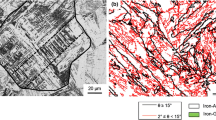Abstract
High-resolution transmission electron microscopy (HRTEM) and X-ray diffraction (XRD) were used to investigate Ni segregation and thermal stability of reversed austenite (RA) in a Fe–Ni alloy processed by quench–lamellarize–temper (QLT) heat treatment. The results show that the 77 K impact energy of the alloy increases with RA content increasing. As an austenite-stabilizing element, Ni is found to segregate in RA, though Ni is not evenly distributed within RA. The amount of segregations increases near the boundary (twice as high as the balanced content) and decreases to some extent in the center of the RA regions. Ni concentration in matrix near the boundary is lower than that in matrix far from the boundary because of Ni atom transportation from α to γ near the boundary. RA in this alloy has high heat and mechanical stability but is likely to lose its stability and transform to martensite when a mechanical load is applied at ultralow temperatures (77 K), which induces plasticity.











Similar content being viewed by others
References
Qian BZ, Zhu JF. Current status and prospect of LNG in the world. LNG Pet. 2008;26(4):34.
Kjarstad J, Johnsson F. Prospects of the European gas market. Energy Policy. 2007;35(2):86.
Ayer R, Koo JY, Bangaru NV, Farah AM, Ford SJ. Metallurgical design of steel plates with advanced cryogenic properties for fabrication of pressurized-LNG containers. Int J Offshore Polar Eng. 2006;16(2):103.
Kubo T, Ohmori A, Tanigawa O. Properties of high toughness 9 % Ni heavy section steel plate and its applicability to 200,000 kl LNG storage tanks. Kawasaki Steel Tech Rep. 1999;40(3):72.
Liu DF, Yang XL, Hou LF, Cui TX, Hu YT, Wei YH. Research and application of ultra-low temperature 9 % Ni steels for LNG tanks. J Iron Steel Res. 2009;21(9):1.
Hou JP, Pan T, Zhu YG, Su H, Yang CF, Zhang WS. Effect of inter-critical quenching on mechanical properties and microstructures of 9 % Ni steel. Trans Mater Heat Treat. 2014;35(10):88.
Morris JW. The role of precipitated Austenite in the grain refinement of lath martensitic steel. In: Proceedings of Second International Conference on Advanced Structural Steels (ICASS 2004) Part 2; Shanghai; 2004. 1.
Zhang K, Tang D, Wu HB. Effect of precipitated austenite of cryogenic toughness of 9 % Ni steel. Hot Work Technol. 2012;8:177.
Guo Z, Morris JW Jr. Martensite variants generated by the mechanical transformation of precipitated interlath austenite. Scr Mater. 2005;53(8):933.
Kim JI, Syn CK, Morris JW. Microstructural sources of toughness in QLT-treated 5.5Ni cryogenic steel. Metall Trans A. 1983;14(1):93.
Fultz B, Morris JW Jr. The mechanical stability of precipitated austenite in 9Ni steel. Metall Trans A. 1985;16(12):225.
Yang YH, Cai QW, Tang D, Wu HB. Precipitation and stability of reversed austenite in 9Ni steel. Int J Miner Metall Mater. 2010;17(5):587.
Xie ZL, Liu ZY. Research on microstructure evolution, alloy elements partitioning and tougening mechanism of 9 % Ni steel. Mater Sci Technol. 2013;21(2):6.
Lu XG, Wang Z, Cui YW, Jin ZP. Computational thermodynamics, computational kinetics, and materials design. Chin Sci Bull. 2014;59(15):1662.
Pan T. Study on microstructures and toughening mechanism of nine percent nickel cryogenic steel for LNG tanks. Beijing: Central Iron and Steel Research Institute; 2015. 61.
Pan T, Zhu J, Yang CF. Kinetics simulation and experimental observation of fine microstructure of 9 % Ni cryogenic steel processed by QLT heat treatment. Chin Sci Bull. 2014;59(15):1765.
Zhao XQ. Research on hot working technology and cryogenic properties of 9 % Ni cryogenic steel. Qinhuangdao: Yanshan University; 2010. 87.
Acknowledgments
This study was financially supported by the National High Technology Research and Development Program of China (No. 2007AA03Z506) and the National Basic Research Program of China (No. 2015CB654803). The authors are grateful to the staff of the Central Iron and Steel Research Institute—Thermo-Calc Software Union Open Laboratory for software support and Dr. Wang Qing-Feng from Yanshan University for valuable discussion.
Author information
Authors and Affiliations
Corresponding author
Rights and permissions
About this article
Cite this article
Pan, T., Zhu, J., Su, H. et al. Ni segregation and thermal stability of reversed austenite in a Fe–Ni alloy processed by QLT heat treatment. Rare Met. 34, 776–782 (2015). https://doi.org/10.1007/s12598-015-0607-1
Received:
Revised:
Accepted:
Published:
Issue Date:
DOI: https://doi.org/10.1007/s12598-015-0607-1




